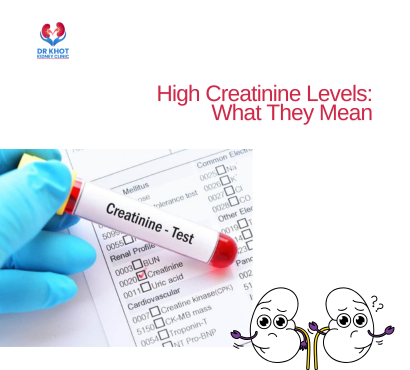Creatinine is one of the key indicators of kidney health tracked during routine blood tests in India and worldwide. When creatinine levels rise above normal, confusion and anxiety are common—especially with increased health awareness, family history of kidney problems, or recent symptoms. But what does “high creatinine” really mean? Does it signal kidney disease, temporary stress, or something else? When should someone take action, and what steps can help control or reverse abnormal readings?
This guide untangles the facts around creatinine, explains its medical significance, and empowers you to make informed decisions, whether for yourself, a loved one, or a patient.
What Is Creatinine?
Creatinine is a natural waste product produced by muscles during the breakdown of creatine—a molecule that helps supply energy.
The kidneys filter creatinine out of the blood, removing it through urine. Healthy kidneys keep blood creatinine within a narrow range.
Typical Normal Values (may vary by lab & age)
| Population | Normal Creatinine (mg/dL) |
| Adult men | 0.7 – 1.3 |
| Adult women | 0.6 – 1.1 |
| Children | 0.2 – 0.7 |
| Elderly | May be slightly higher |
If kidneys don’t work as efficiently, creatinine stays in the blood and may increase.
Reasons for High Creatinine Levels
1. Kidney Dysfunction
Most commonly, rising creatinine signals impaired kidney function.
Possible causes in India include:
- Chronic kidney disease (CKD)
- Glomerulonephritis
- Polycystic kidney disease
- Blocked urine flow (stones, enlarged prostate)
2. Dehydration and Diet
Temporary increases can stem from dehydration, not drinking enough water, or eating too much protein/meat before the test.
3. Intense Physical Activity
Heavy gym workouts or athletic events can bump up creatinine naturally—muscles create more and kidneys struggle to keep pace temporarily.
4. Certain Medications
Painkillers (NSAIDs), antibiotics, or blood pressure meds might raise creatinine by stressing the kidneys. Discuss these with your healthcare provider.
5. Acute Conditions
- Sudden infection
- Heart failure
- Excessive bleeding
- Severe urinary tract infections
Sometimes, creatinine rises for short periods, then falls after treatment.
When Is High Creatinine Dangerous?
Warning Levels
- Mild: 1.3 – 2.0 mg/dL
- Moderate: 2.0 – 5.0 mg/dL
- Severe: >5.0 mg/dL
| Creatinine Level | Typical Meaning | Action Needed |
| 1.3 – 2.0 | Mild kidney stress, often reversible | Hydration/test follow-up, diet |
| 2.0 – 5.0 | Chronic or serious kidney disease | Specialist care, full evaluation |
| >5.0 | Severe/failing kidneys | Emergency care |
Abnormal levels should always be discussed with a doctor—context matters.
Key Symptoms Associated with High Creatinine
High creatinine itself does not produce symptoms.
But, if kidney function is impaired, these symptoms may develop:
- Swelling of feet and ankles
- Fatigue and weakness
- Nausea, vomiting
- Urine changes (foam, dark, less volume)
- Shortness of breath
- High blood pressure
- Itchy skin
If these develop alongside high creatinine, prompt medical review is necessary.
Testing Creatinine in India
Doctors order blood creatinine and calculate eGFR (estimated glomerular filtration rate) to measure kidney function accurately.
Periodic testing is routine for people with diabetes, hypertension, or family history of kidney disease.
What to Do If Your Creatinine Is High
Step 1: Don’t Panic—Repeat the Test
- Hydration, rest, and avoiding high-protein foods can lower levels in some cases.
- If levels stay high, further tests will clarify the cause—urinalysis, eGFR, ultrasound, additional blood work.
Step 2: Review Medications and Lifestyle
- Inform the doctor of all medicines, supplements, and workout or dietary changes.
Step 3: Specialist Referral
- Nephrologist (kidney specialist) care may be needed for persistent or severe elevation.
Step 4: Monitor Other Health Risks
- High blood pressure, diabetes, infection, or heart disease must be controlled.
Treatment for High Creatinine
Treatment is not about fixing the creatinine itself, but addressing the underlying problem:
- Manage blood pressure and diabetes tightly
- Treat dehydration or infection
- Adjust or stop harmful medications
- Adopt kidney-safe diet (less salt, less red meat, more vegetables)
- Control fluid intake, especially in advanced kidney disease
Dialysis or transplant are options only for advanced/failing cases.
Can High Creatinine Be Prevented or Reversed?
Yes—if caught early and the cause is addressed, kidney function sometimes recovers or stabilizes.
- Regular health checks
- Early control of diabetes or hypertension
- Timely management of urinary infections or stones
- Healthy lifestyle and hydration
Who Is at Risk in India?
- People with diabetes or hypertension (common in Indian adults)
- Those with kidney stone history or recurrent infections
- Older adults
- Family history of kidney disease
- Excess supplement use (protein powders, herbal treatments)
Community awareness and timely testing are key.
Role of Diet, Hydration, and Indian Habits
- Drink water regularly (but don’t overdo in advanced kidney disease)
- Moderate protein, avoid excessive red meat and salty pickles
- Limit processed foods—chips, ready meals, instant noodles
- Seek medical advice before taking herbal remedies or supplements
Traditional diets with dals, vegetables, whole grains, fruits, and curd are kidney-friendly.
FAQ
- What foods should I avoid if my creatinine is high?
Limit red meats, processed and salty foods, canned soups, pickles, and excess dairy until you consult your doctor. Preference is given to grains, legumes, lean chicken/fish, and fresh fruits and vegetables. - Can dehydration really raise my creatinine?
Yes—lack of fluids causes concentrated blood and less filtration, temporarily raising creatinine. Proper hydration can normalize values where dehydration is the cause. - Is high creatinine always a sign of permanent kidney damage?
No—sometimes levels go up transiently after exercise, infection, certain medicines, or dehydration. Persistent elevation, especially with abnormal eGFR, may signal chronic disease.

